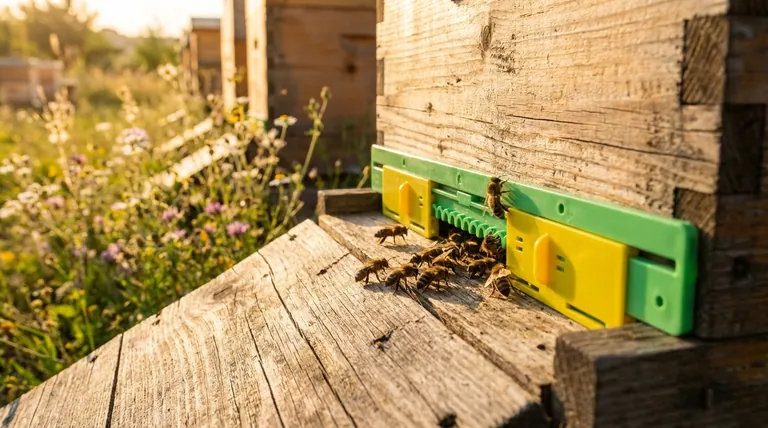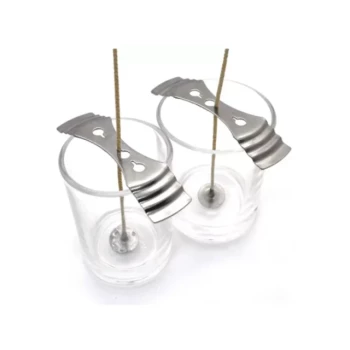An entrance reducer is a simple but essential tool used to manage the size of a beehive's main entrance. It is most critically used when a colony is new, small, or weak, as it makes the entrance easier for a limited number of bees to defend. It is also a standard tool for preparing a hive for winter and protecting it from robbing by other insects.
The decision to use an entrance reducer is not about a fixed calendar date; it's a strategic response to your colony's current strength. It's a constant balance between providing security for a vulnerable hive and ensuring maximum efficiency for a strong one.

The Primary Role: Fortifying the Hive Defense
A beehive entrance is the single point of entry for resources and the single point of failure for defense. Managing its size is a primary responsibility of the beekeeper.
For New and Small Colonies
When you first install a package of bees or a small nucleus colony, their population is low. They cannot effectively guard a full-sized entrance against intruders like wasps, yellow jackets, or robbing honeybees.
Using an entrance reducer with the smallest opening creates a defensible chokepoint. This allows a small number of guard bees to effectively protect the colony while the population grows.
Preventing Robbing During a Dearth
During late summer or fall, natural nectar sources can become scarce (a period known as a "dearth"). This is when strong, hungry colonies may try to "rob" the honey stores of weaker hives.
A reduced entrance is the number one defense against robbing. It limits the access point for invaders, giving the home colony a significant defensive advantage.
Aiding Weak or Stressed Hives
If a hive is weakened by disease, pests like Varroa mites, or a failing queen, its population will decline. These hives are prime targets for robbers and pests.
An entrance reducer supports these vulnerable colonies by minimizing the area they need to defend, allowing them to focus their energy on recovery and brood rearing.
Environmental Control and Wintering
Beyond defense, an entrance reducer plays a key role in helping the colony manage its internal environment, especially during cold weather.
Reducing Drafts and Conserving Heat
During winter, the bee cluster must generate heat to survive, maintaining a core temperature around 95°F (35°C). A large, open entrance allows cold drafts to enter the hive, forcing the bees to expend more energy and consume more honey to stay warm.
Reducing the entrance helps minimize heat loss and protects the colony from harsh winter winds.
Pest and Rodent Defense
As temperatures drop, mice seek warm, sheltered spaces with a food source. A beehive is a perfect target.
An entrance reducer, especially when set to its smallest opening, acts as a mouse guard, physically blocking them from entering the hive. For absolute protection, a dedicated metal mouse guard is more effective against determined rodents.
Understanding the Trade-offs: When to Remove the Reducer
Using an entrance reducer on a strong, thriving colony can do more harm than good. Knowing when to remove it is just as important as knowing when to use it.
The Foraging Bottleneck
During a heavy nectar flow in spring and summer, a large, populous hive has thousands of foragers flying in and out. An entrance reducer creates a traffic jam, or "bottleneck," at the entrance.
This bottleneck slows down foraging, reduces the amount of nectar coming in, and limits the colony's productivity. If you see a traffic jam of bees at the entrance, it's time to provide a larger opening or remove the reducer completely.
Overheating and Bearding
Bees also use the entrance for ventilation to control the hive's internal temperature and humidity. On hot days, a restricted entrance can lead to overheating.
You may see a behavior called "bearding," where a large number of bees cluster on the outside of the hive to cool down. This is a clear sign that the hive needs more ventilation and the entrance reducer should be removed.
Assessing Colony Strength
A strong colony with a large population can easily defend a full-sized entrance. They will have a robust force of guard bees ready to handle any threats.
Once a new colony has filled its first brood box with bees and is showing heavy flight activity, you can typically widen the entrance or remove the reducer, weather and robbing threats permitting.
Making the Right Choice for Your Hive
Your decision should always be based on direct observation of your specific colony and its environment.
- If you just installed a new package or nuc: Use the smallest opening on the reducer to give the bees a secure start as they build their population.
- If your colony is large and active during a summer nectar flow: Remove the reducer entirely to maximize foraging efficiency and prevent overheating.
- If you observe robbing behavior or persistent wasp attacks: Immediately install a reducer set to its smallest opening, regardless of the season.
- If you are preparing for winter: Use the reducer to protect against mice and reduce cold drafts once the weather cools and flight activity slows.
By treating the entrance reducer as a dynamic tool, you move from following rigid rules to making informed decisions that ensure your colony's health and security.
Summary Table:
| Situation | Recommended Action | Key Benefit |
|---|---|---|
| New/Small Colony | Use smallest opening | Easier defense, supports population growth |
| Robbing Threat (e.g., nectar dearth) | Use smallest opening | Protects honey stores from invaders |
| Weak/Stressed Hive | Use reducer | Conserves energy for recovery |
| Winter Preparation | Install reducer | Reduces drafts, deters mice |
| Strong Colony, Heavy Nectar Flow | Remove reducer | Maximizes foraging efficiency, prevents overheating |
Ensure Your Apiary's Success with the Right Equipment
Managing your hive's entrance is just one part of a successful beekeeping operation. HONESTBEE supplies commercial apiaries and beekeeping equipment distributors with the durable, high-quality supplies needed to build and protect thriving colonies.
From entrance reducers and mouse guards to full hive systems, our wholesale-focused operations provide the reliable equipment that underpins productive beekeeping.
Let's strengthen your business together. Contact our team today to discuss your supply needs and discover the HONESTBEE advantage.
Visual Guide

Related Products
- Multi-Functional Sliding Hive Entrance for Beekeeping
- Multi-Functional Rotary Hive Entrance Disc for Beekeeping
- Professional Insulated Winter Hive Wrap for Beekeeping
- Professional Large-Format Hive Number Set for Beekeeping
- Automatic Honey Flow Beehive 4 Frame Mini Hive for Beekeeping
People Also Ask
- How can a Langstroth hive entrance be adjusted? Mimic Natural Bee Preferences for a Healthier Hive
- What additional functions do hive entrances serve? A Key to Colony Health, Security, and Productivity
- What size is the entrance hole in a native bee hive? The 13mm Standard for a Thriving Colony
- What are the different entrance sizes for an 8 or 10-frame Langstroth hive? A Guide to Seasonal Management
- What is the purpose of placing an object in front of the hive entrance after a move? A Guide to Forced Reorientation



















